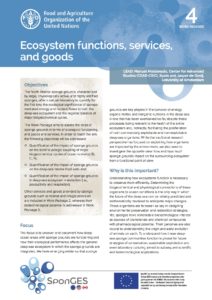Objectives. The North Atlantic sponge grounds, characterized by large, physiologically active, and highly silicified sponges, offer a natural laboratory to quantify for the first time the ecological significance of sponge-mediated energy and nutrient fluxes to both the deep-sea ecosystem and the regional balance of major biogeochemical cycles. Work Package 4 aims to assess the roles of sponge grounds in terms of ecological functioning, and goods and services. In order to reach the aim, the following objectives will be addressed:
- Quantification of the impact of sponge grounds on the benthic-pelagic coupling of major biogeochemical cycles of ocean nutrients (Si, C, N);
- Quantification of the impact of sponge grounds on the deep-sea marine food web; and
- Quantification of the impact of sponge grounds in deep-sea ecosystem metabolism (i.e., productivity and respiration).
Other services and goods provided by sponge grounds such as habitat and refugia provision are included in Work Package 2, whereas their biotechnological potential is addressed in Work Package 5.
Focus. The focus is to uncover and document how deep-ocean areas with sponge grounds are functioning and how their ecological performance affects the general deep-sea ecosystem in which the sponge grounds are integrated. We have emerging evidence that sponge grounds are key players in the turnover of energy, organic matter, and inorganic nutrients in the deep-sea. A role that has been overlooked so far, despite these processes being relevant to the health of the entire ecosystem and, indirectly, facilitating the proliferation of both commercially exploitable and non-exploitable deep-sea organisms. While the traditional research perspective has focused on explaining how organisms are impacted by the environment, we also seek to investigate the opposite view: how and how much sponge grounds impact on the surrounding ecosystem from a functional point of view.
Why is this important? Understanding how ecosystems function is necessary to preserve them efficiently. Determining the biogeochemical and physiological connections of these organisms to ocean conditions is the only way in which the future of the deep sea can be reliably predicted and mathematically modeled to anticipate major changes. These organisms are foreseen as key in designing environmental preservation and restoration strategies. Yet, sponges have remarkable biotechnological interest as sources of biomaterials and chemical compounds with pharmacological potential. Their genomes are also crucial to understanding the origin and early evolution of animals on earth. To understand how these deep-sea sponge communities function is pivotal for future strategies of conservation, sustainable exploitation and even laboratory culturing aimed to subsequent scientific and biotechnological applications.
Discover more about SponGES WP4 – download the WP4 Infosheet here.
